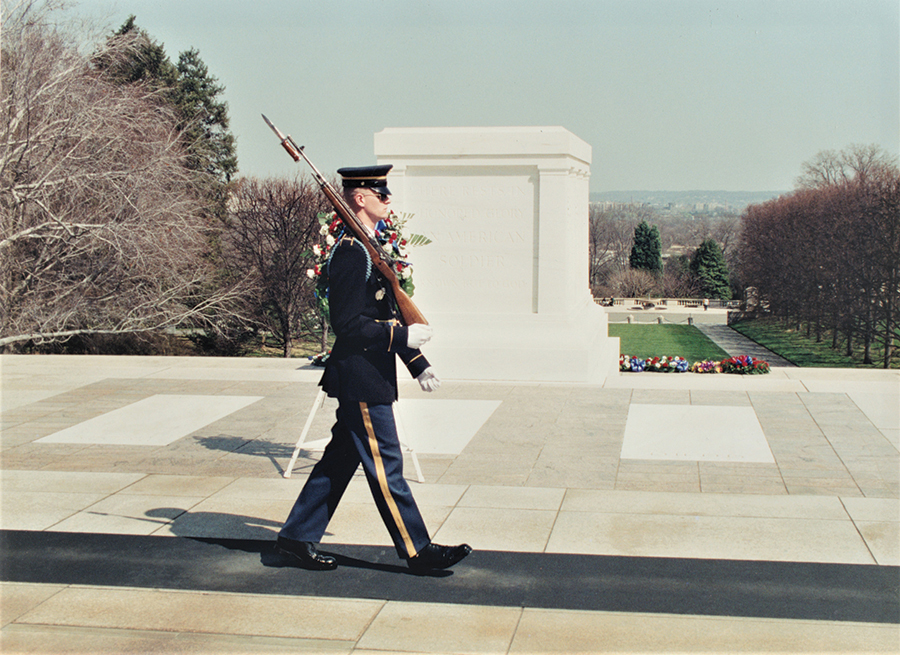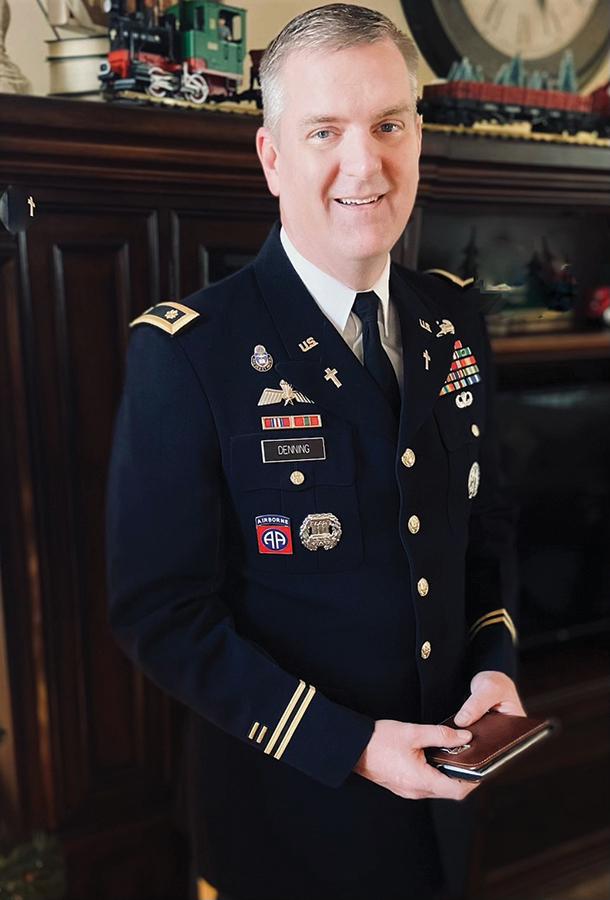
BLYTHWOOD – Dedicated on Nov, 11, 1921, the third anniversary of the conclusion of World War I, the Tomb of the Unknown Soldier is an official military post and, since 1948, has been guarded 24-hours-a-day by a special group of guards from the 3rd U.S. Infantry Regiment — “The Old Guard.”
A Blythewood man, Chap. (Maj.) Brandon Denning, was the 453rd soldier to guard the Tomb.
Though almost 700 men and women have been awarded the Tomb Guard Identification Badge (TGIB) since counting began in 1958, Denning is the only person who has served as a member of The Old Guard and returned as a chaplain to the guard unit.
Growing up in South Mills, North Carolina, Denning said he had “no real aspirations at the time to go into ministry or the military.” Though he made the decision to follow Christ as a 13-year-old, he says he began to ask questions about his faith.
“I wanted to be serious about following the Lord,” he said.
After high school graduation, Denning enlisted in the United States Army. The U.S. Army’s 1990s recruiting slogan, “Be all that you can be,” inspired Denning, but so did stories of his grandfather, Roy Denning, an Army Technical Sergeant (TSgt) who served in World War II.
The elder Denning was responsible for transporting U.S. servicemen to the beaches of Normandy for the D-Day invasion on June 6, 1944. Though he passed away before Denning was born, the younger Denning was motivated to serve his country, specifically through the Army.

After Denning began his time of service in the Army in May 1996, assignment at the Tomb of the Unknown Soldier was not automatic but required try-outs through a rigorous initial selection process that included height and weight requirements, a high score on physical fitness, and a security clearance due to proximity to dignitaries who visit the site. Once these standards are met, sentinel hopefuls then visit Arlington’s grounds in groups for further testing.
“There are trials twice a year and you went and tried out and if you did not pass the requirements at any point, they failed you,” Denning explained.
When Denning went with his group of seven comrades for try-out at Arlington in 1996, the group was tested in three areas: history of the cemetery, military uniform, and the “manual.”
Each of the areas is graded and “it’s very much of a mental kind of game that you have to go through,” Denning said.
Candidates must memorize the locations of fallen soldiers and dignitaries, as well as the history of the cemetery, keep their uniform to the Sentinel Creed’s standard of perfection, and do all actions according to the manual for service as a sentinel, including walking, timeliness, and other standards.
“The idea is for us to give our best to the unknowns,” Denning explained. “Everything is very rigid and meticulous.”
Only two soldiers were selected as sentinels that year, and Denning was one of them.
While calling the opportunity to serve as a sentinel “very rewarding,” Denning said the time he spent as a guard, from 1996-1999, gave him the perspective “that life is fleeting [and] there are sacrifices that have to be made for our freedom.”
“A lot of the Tomb of the Unknown Soldier [correlates] to the sacrifice that our Savior has made for us on the Cross,” Denning said, though he is careful not to take the analogy too far.
“I think we have to realize that life is about sacrifice and sometimes we are going to be called to sacrifice for the greater good and that’s exactly what those soldiers represent,” an emotional Denning explained. “They lost everything, to include their identities, and that is something this country nor I should take lightly.”
The site as it is known today was built in 1926, with the remains of the World War I Unknown Soldier buried under the sarcophagus. The crypt in front of the sarcophagus is divided into three sections and holds the remains of U.S. soldiers from World War II, the Vietnam War, and the Korean War.
Although he was successful in the Army, by the world’s standards, Denning said he was falling apart spiritually. He said that is one of the reasons he got out from a first enlistment in 1999.
He enrolled at the University of Tennessee at Chattanooga, where the singles’ pastor at a local church, who was also a friend, began to mentor and disciple Denning.
“I was wrestling with a call to ministry, but I had no plans to become a chaplain,” Denning recalled.
However, his friend took him around to visit seminaries, and Denning soon landed in Fort Worth at Southwestern Seminary where he was focused on counseling. But a change in the program led him to begin working on a Master of Divinity degree with biblical languages and a concentration in pastoral counseling.
During this time, Denning was exposed to the ministry of chaplaincy and, following graduation in 2008, was commissioned as a chaplain in the Army and assigned to the 82nd Airborne. The next year he enrolled in chaplaincy school at Fort Jackson Army Base in Columbia.
After a 2009 – 2010 deployment to Afghanistan with the 4th Brigade of the 82nd Airborne Division, Denning returned to Fort Bragg in Fayetteville, N.C., and was reassigned to Arlington National Cemetery.
For six months Denning conducted funerals at the cemetery until he was reassigned as chaplain to the 4th Battalion – the battalion in charge of the Tomb of the Unknown Soldier, a role he served in for three years and that he recalls was a great fit and a real joy.
Denning was reassigned to Ft. Jackson where he continues to serve as chaplain, a role he says he values as he helps soldiers who have questions about life, death, and suffering.
Reprinted with permission from the 2022 issue of Southwestern News, a publication of the Southwestern Baptist Theological Seminary.
Except One
On the Virginia side of the Potomac River, overlooking Washington, D.C., and the nation’s tributes to the fallen of World War II and the Korean and Vietnam wars, Arlington National Cemetery serves as a silent reminder freedom comes with a cost.
Opened in 1864 by the then-War Department as the nation’s military burial site, the cemetery is the final earthly resting place for over 400,000 of the country’s active-duty service members, veterans, and their eligible dependents dating back to the Civil War.
On carefully placed white grave markers that make up the cemetery’s perfectly lined rows, the names of men and women who have worn the flag of the United States as a member of one of the five branches of the military are etched in capital letters on each of the tombstones.
Except one.
In section 48 of the cemetery, resting at the top of the stairs leading to the east side entrance of the cemetery’s Memorial Amphitheater, is the Tomb of the Unknown Soldier. The most iconic of all of Arlington’s memorials, the tomb’s sarcophagus bears no name. Engraved on the tomb’s west side panel are the words, “Here rests in honored glory an American soldier known but to God.”
The memorial site is a solemn and quiet place as visitors reflect on military service while watching the sentinel on duty take 21 measured footsteps before pausing for 21 seconds, turning to face the tomb for 21 seconds, and turning to repeat the pacing as he stands guard over his fallen comrades’ remains.
The lone sounds come from the steel shank on the inside of the heels of the sentinel’s shoes that enable the soldier to “click” during certain movements, such as the changing of the guard. The respect and dignity warranted at the site are unspoken, though signposts serve as muted reminders and military personnel serve as verbal reminders when necessary.











